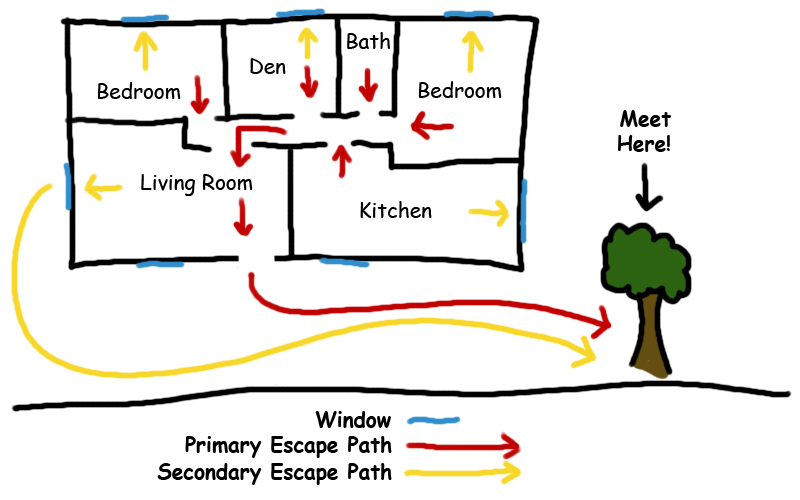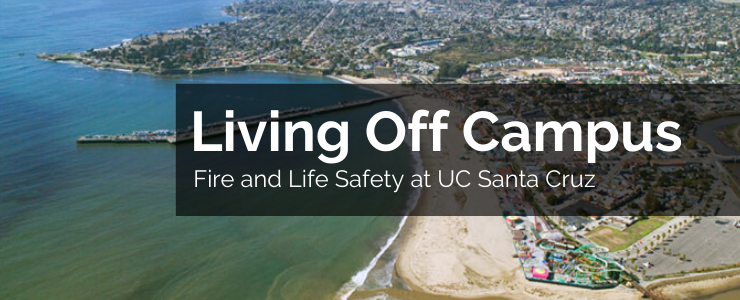Living Off Campus
Fire Safe Off-Campus Housing - What To Look For and Ask?
Many UCSC students reside in off-campus living arrangements. These living arrangements do not offer the same standard approaches that UCSC housing does but rather may be customized based on zoning laws and housing codes. This section will attempt to break down how to assess the safety of an off-campus residence and ways that you can proactively ensure your safety when living off-campus.
Building Safety Features
This section will cover off-campus housing for students who do not live in residences operated by UCSC Housing. Please note that off-campus housing units do not have to abide by the same requirements as on-campus housing. Therefore, there will be several differences of note between on-campus and off-campus safety offerings.
Fire Sprinklers
A notable difference between on-campus and off-campus housing are fire sprinkler requirements. In on-campus housing, fire sprinklers are a required component of fire safety for all residents. However, this is not the case for off-campus housing. Depending on the municipality, fire sprinklers may not be required.
Fire Sprinklers function as rapid firefighting equipment that can quickly subdue small fires before a dedicated response occurs. Fire Sprinklers generally take advantage of the fact that hot air rises. When the air near a fire sprinkler nozzle approaches between 135 and 165 degrees Fahrenheit, a bulb blocking water flow bursts and pressurized water douses a wide area around the sprinkler.
A single fire sprinkler can discharge 10-25 gallons of water in one minute. If it doesn't completely subdue a fire, it mitigates the flames, limits the development of smoke, and prevents nearby material from being easily combustible fuel for the fire. Fire Sprinklers are an incredibly useful apparatus for firefighting.
An important consideration is that fire sprinklers are only as effective as the range of their reach. If you have furniture or other obstructions blocking the path of the sprinkler, that limits the effective range. Additionally, make sure that you are not hanging any items from a fire sprinkler.
Smoke Detectors
Although fire sprinklers are not a requirement for off-campus housing, smoke detectors are a requirement. Smoke Detectors are early warning devices that indicate when a fire is developing. They can be triggered through the automatic detection of smoke.
An essential component of the fire alarm apparatus, smoke alarms detect low levels of smoke through ionization or photoelectric processes. Upon detection, they emit a loud alarm designed to alert those inside the structure of the danger.
Smoke detectors can be set up in a multitude of configurations. Some are 'networked' detectors. This configuration allows for all local detectors to trigger after a single detector is activated. This allows for rapid notification of an entire area's inhabitants of potential danger.
Another way that detectors are set up is the singular configuration. In this configuration, the detector is not networked and only functions to alert people in the immediate vicinity of potential danger.
Carbon Monoxide
Carbon Monoxide detectors are required in any housing unit that has gas-fed appliances. Building owners should know if the unit has gas-fed appliances and if the unit is equipped with Carbon Monoxide detectors.
Carbon Monoxide (CO) is an invisible, odorless, and colorless gas created by the burning of fuels such as in cars, trucks, stoves, lanterns, grills, fireplaces, gas ranges, or furnaces (CDC). Carbon Monoxide is lethal in sufficient quantities and can kill without symptoms for those who are asleep or under the influence of alcohol. Carbon Monoxide detectors are devices that detect when a dangerous level of CO exists within range. On detection, CO alarms will emit blaring sounds similar to those of a smoke or fire alarm.
When a Carbon Monoxide detector sounds, your first priority should be fresh air and informing anybody else in the home of the danger. Open windows and sliding doors. Ensure that there is fresh air coming into the area. If this is not possible, leave and call for help from an area where there is fresh air.
More Information
Campus Fire Safety - Fire Sprinklers (PDF)
NFPA - Fire Alarms in Apartments (PDF)
NFPA - Carbon Monoxide Safety (PDF)
NFPA - Deaf and Hard of Hearing Smoke Alarms (PDF)
Emergency Preparedness Before You Lease
In off-campus housing, evacuation planning is much less standardized than on-campus offerings. In these cases, it is instrumental that you take the initiative to ensure your safety when living off-campus. When selecting an off-campus residence, ask your prospective landlord questions about the residence such as:
- Does every room have a smoke detector? What is it powered by? Does it send a signal to the local fire department? Are batteries changed when clocks are changed? Who provides battery replacements?
- Does the building have fire sprinklers or fire extinguishers? Where are they?
- Do the rooms have enough outlets with enough power to feed energy needs? Are there recommended limits?
- In the event of a fire, is there an evacuation zone? How often are drills conducted?
Additionally, maintain your own checklist of safety priorities that you can check off to ensure that a housing offering meets your needs. These are requirements that can be met both before you move in and during your time living there. We recommend ensuring the following:
Before You Lease:
- Every room is equipped with a smoke detector and they are interconnected such that when one sounds, they all sound.
- The home has carbon monoxide detectors.
- Smoke and carbon monoxide detectors are regularly tested at least once a month.
- A list of emergency numbers including the local fire and the police departments is on the refrigerator.
- The home has a fire sprinkler system.
- There are at least two ways out of every room.
- All windows and doors open easily.
- Escape routes are free from clutter or obstructions.
- There is an outside meeting place where everyone can meet when the smoke alarm sounds.
While You Lease:
- Everyone participates in fire drills at least twice a year.
- Smoke and Carbon Monoxide detectors have their batteries checked/replaced whenever clocks are changed (twice a year)
- Home escape plans are reviewed with overnight guests.
- Smokers smoke outside and use sturdy, deep, non-tip ashtrays.
- One heat-producing appliance is plugged into a wall outlet at a time.
- Candles are placed in sturdy candleholders and are blown out whenever you leave the room or go to bed.
- Candles are kept at least 12 inches from anything that can burn.
- You stay in the kitchen while cooking.
- You do not cook if you have been drinking, am too tired to function, or have taken medications or drugs that make you feel drowsy.
Resident Escape Plan
When living off-campus, you will not have access to the same evacuation plans that all on-campus residents have access to. Instead, you will need to take the initiative to create your own Resident Escape Plan. You can create and implement this plan by following these simple steps:
- Draw a map of your home showing all walls, doors, and windows. (Feel free to ask your landlord if they have a floor plan you can use).
- Draw arrows from every room and hallway that illustrate where someone can exit the home from anywhere within it. Use one color for a primary evacuation route and a different color for a secondary route.
- Draw arrows from the home's exits to a safe area where the home's inhabitants can gather when there is an emergency. (Use markers like trees, light poles, or mailboxes to help guide where to go!)
Here is a rudimentary example that shows these steps in action. Note that your diagram does not have to be absolutely spot-on with a ruler, getting the general idea across is the important part!

Once you have created an evacuation plan, it is important that you see it in practice! Make sure to practice evacuations both during the day and at night at least twice every year. Also, practice using your primary and secondary evacuation routes. Finally, when evacuating make sure to close doors behind you to limit the spread of a fire.
More Information
Campus Fire Safety - Know Your Escape and Practice It (PDF)
Setting Up Your Living Space
Once you move into your new residence, it is important that you take steps to minimize the dangers you may face. First and foremost you should check if there is anything defective or in need of repair in your residence. Upon discovery, you should notify your landlord immediately to make the appropriate repairs and replacements.
As you move in furniture and belongings, there are several priorities you should abide by when setting up your housing configuration:
- Make sure that none of your furniture or belongings are blocking exits to rooms or the home.
- Make sure that you are not hanging anything from fire sprinklers.
- Make sure that you are not obstructing a fire sprinkler or smoke detector by placing anything that could prevent a fire sprinkler from dousing the entire room.

